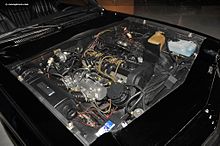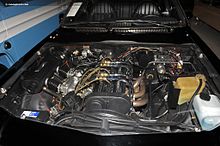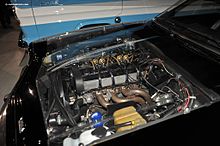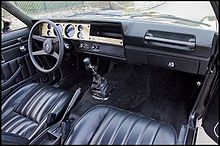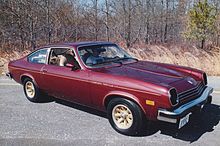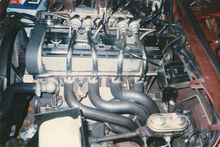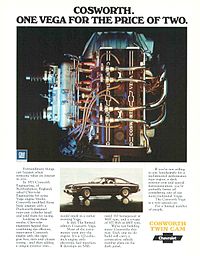- Chevrolet Cosworth Vega
-
This article is about the Chevrolet Cosworth Vega. For general Vega information, see Chevrolet Vega.
Chevrolet Cosworth Vega 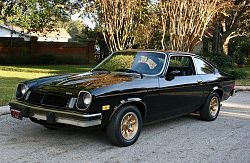
1975 Chevrolet Cosworth Vega Hatchback CoupeManufacturer Chevrolet Division
of General MotorsAlso called Cosworth Twin-Cam Production 1975–1976 Model years 1975–1976 Assembly Lordstown Assembly-
Lordstown, Ohio, United StatesClass Subcompact Body style 2-door hatchback coupe Layout FR layout Platform GM H platform (RWD) Engine 122 cu in (2.0 L) DOHC EFI I4 Transmission 4-speed manual
5-speed manual w/overdrive (1976)Wheelbase 97.0 in (2,464 mm) Length 176.4 in (4,481 mm) Width 65.4 in (1,661 mm) Height 50.0 in (1,270 mm) Curb weight 2,760 lb (1,250 kg) Designer GM & Chevrolet Design staffs
Chief Stylist, Bill Mitchell
Engine Designer, Calvin WadeThe Chevrolet Cosworth Vega is a subcompact four-passenger automobile produced by the Chevrolet division of General Motors for the 1975–1976 model years. The Cosworth Twin-Cam is a limited production, performance version of the Vega. Its purpose was to "create excitement for the entire Vega line." The vehicle was introduced to the public at the Chicago Auto Show in February 1975.[1]The production version of the Cosworth Vega twin-cam engine was developed by Chevrolet with the cylinder head design assisted by Cosworth Engineering in England. The all-aluminum 122 cu in (1,999 cc) inline-four engines were hand-built at GM's Tonawanda engine plant — each signed by the engine builder. Cosworth. One Vega for the price of two[2] was only $900 less than the 1975 Chevrolet Corvette. 5,000 engines were built, but only 3,508 cars were produced in 18 months.[3]
Contents
History
Racing origin
The Cosworth racing engine based upon the Vega aluminum block was known internally at Cosworth Engineering as Project EA. The EA engine produced a reported 260 hp (190 kW). Installed in Chevron and Lola chassis, it proved the fastest in the 2-liter class in its first outings. Chevrolet, who had been keeping close tabs on the project, began considering a version of the engine to offer as an option for the Vega. The ZO9 Cosworth Vega is a direct derivative of the EA racing engine. Although it has been widely thought of by the general public as a souped up Vega engine, it is in truth a de-tuned EA racing engine. It lacks the EA's dry sump lubricating system (neither necessary nor desirable for passenger car application), has a lower compression ratio and different valve timing and uses Bendix electronic fuel injection in place of the Lucas mechanical injection, but bore, stroke and valve sizes are identical. The Bendix injection is actually more sophisticated than the Lucas since it has to cope with a wider range of operating conditions as well as emission controls.[4]
Development
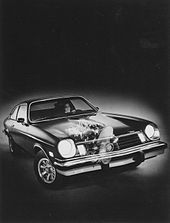 Chevrolet press kit photograph, 1975
Chevrolet press kit photograph, 1975
In March, 1970 John DeLorean, then Chevrolet's general manager and vice-president of General Motors, sent engine designer Calvin Wade, a 25-year veteran of Chevrolet performance wars, to England in search of cylinder head technology that would pep up the Vega's engine demeanor. It would take some new technology — fuel injection to control emissions without power loss — and far stouter internal parts to work with the existing block and the Cosworth head. By the Summer of 1970, DeLorean authorized Wade to build the prototype for what would become the Cosworth Vega. But the budget was meager and stout resistance from managers between Wade and DeLorean resulted in low priority for the project. On the positive side, no one could kill the idea once it received approval from John Z.
Prototype parts were in and assembled June, 1971. The Cosworth Vega engine (street version) came to life for the first time. Breathing through a pair of Holley-Weber two-barrel carburetors, the Cosworth quickly turned in a peak of 170 hp (130 kW). By Easter, 1972 a key break for the Cosworth engine came when several advanced Vega creations were offered to GM President Edward Cole for a drive. A base Vega was on hand for reference to an all-aluminum small-block V8 and the Bendix-injected Cosworth. Ed Cole loved the Cosworth concept and pledged his support in the Engineering Policy Group, which would have to approve DeLorean's request to initiate production. DeLorean's first ride came a few months later. His approval for development — aimed at U.S. Environmental Protection Agency (EPA) certification swiftly followed. Cal Wade began a development program with 12 cars to accumulate emissions certification mileage and prove the engine in a variety of circumstances including high altitudes and hot and cold climates. At the GM desert proving ground, the car could reach 122 mph (196 km/h).
In April, 1973 the design was frozen and two cars were built for the mileage accumulation necessary for EPA emission certification. The press was keyed into the program and a pilot car was the center of attention in the August 1973 Car and Driver, alerting the public to an upcoming 140-hp Cosworth Vega. But what the engine needed was dyno-time, new cam profiles to trade in a little high-end punch for a lot more muscle in the low end and a tubing header to replace the undesirable cast iron exhaust manifold. It meant a much higher priority for the project: more engineering manpower, more money — and also more delay. A chance for a major engineering coup by Chevrolet was clearly within reach if it could get a certified race engine into production. Everyone was watching: Chevy dealers were accepting huge deposits for an early delivery.
Once again the design was frozen in January, 1974. A stainless steel header was specified, which helped horsepower from 2,000 rpm up to the 7,000 rpm redline. Camshaft lift and duration were eased back and throttle area sized down to reshape the torque curve to a street-oriented curve that peaked at 5,200 rpm. William Large, project coordinator for several months, built two durability cars and sent them off and running. By April 1974, emissions performance for the first 40,000 miles (64,000 km) showed the Cosworth Vega to have a truly "clean" engine. But then hydrocarbon curves on the first car shot upward at a precipitous rate, far exceeding the allowable 3.0 grams per mile. Disassembly revealed burned exhaust valves. For certification of the Cosworth Vega, five months of durability miles would have to be reaccumulated. Chevrolet argued in vain with the EPA to allow averaging between the two cars.
A new round of development was begun, this time to improve emissions durability and also to ready the engine for more stringent 1975 standards. The fuel injection was redesigned for better air distribution. High-energy electronic ignition was added along with the mandatory catalytic converter. A Pulse Air system was added. Functionally, Pulse Air is the same as an air pump but without the pump's six-hp loss. The larger version catalytic converter also prevented a power loss. More advanced timing and the lead-free fuel required with the converter would cancel any likelihood of exhaust-valve failure. One of Chevrolet's criterion is that all engine designs live for 200 hours at full load. The Cosworth Vega endured the punishment for over 500 hours. For a clutch burst test, Cale Wade bravely buzzed the engine up to 9,400 rpm under its own power. Both the clutch and the engine lived. Three cars began mileage accumulation once again in September 1974 - in three different configurations to insure passage.
By January, 1975 mileage accumulation was completed with no failures. One configuration stayed within 1975 California limits, making the Cosworth Vega the only GM car certified for all 50 states. All cars came close to passing the proposed 1977 Federal standards. On March 14, 1975 the EPA issued Chevrolet an emissions certificate allowing sale of 1975 Cosworth Vegas. Production was begun immediately to fill the backlog of orders. Engine production rate was 30 per day with hand assembly teams two or three workers per engine in the Tonawanda, New York engine plant's "clean room", a special facility originally devised for the ZL-1 all-aluminum 427 cu in (6,997 cc) V8. At the Vega's Lordstown assembly plant, the Cosworth rate was 1.6 cars per hour.[5]
Overview
All 2,061 1975 Cosworth Vegas were finished in black acrylic lacquer with gold "Cosworth Twin Cam" lettering on the front fenders and rear cove panel and gold pinstriping on hood bulge, body sides, wheel openings, and rear cove. The black exterior color wasn't available on lesser Vegas until mid-1976. Most 1975 Cosworth Vegas have black interiors; the custom interior with perforated vinyl seat trim (RPO ZJ1) was standard; black cloth seat inserts were available at an additional charge of $50. Approximately 16 percent were equipped with white vinyl interiors. Included was a gold engine-turned dash bezel and gold-plated dash plaque with build sequence number, a specific 8,000 rpm tachometer, and a Cosworth Twin-Cam Vega steering wheel emblem.
At $5,916 it cost double a normal hatchback and $892 less than a Corvette.[6] The Cosworth package includes a 'torque arm' rear suspension which provides optimum rear axle power control. This unit compares to the assembly used on the Monza 2+2. The Monza 2+2 axle is also used and provides a 3.73:1 gear ratio from a 7.5-inch (190 mm) ring gear. No other gear ratios were available, but a limited slip differential was optional. Included were GT springs, shocks, and stabilizer bars (the rear bar larger than the Vega GT's), exclusive BR70-13 BSW radial tires on British-made 6 inch, gold-painted cast aluminum wheels with Chevy center caps, black-finished wiper arms, H.D. radiator and provisions for “Fast Steer” option. This was the first use of electronic fuel injection on a Chevrolet passenger car.[7] Air conditioning was not offered on the Cosworth Vega. Power steering and power brakes were also not offered.[8]A pilot line 1976 model was built in September 1975, but volume 1976 production didn't begin until December 1975.
1976 models at $6,066 received a facelift including a wider grill and tri-color tail lamps and extensive body anti-rust improvements. A new Borg-Warner five-speed manual overdrive transmission with 4.10 axle was optional in addition to the std. Saginaw four-speed manual with 3.73 axle. The exhaust system featured a single outlet tailpipe as opposed to the dual outlet pipe on the 1975. The seat trim changed to a grained vinyl and the optional cloth trim seat inserts was changed to a "houndstooth" type, named sport-cloth, for an additional $18 charge. In January, a "Sky-Roof" with tinted reflectorized sliding glass and 8-track tape player options were added. In February, eight of the Vega's fourteen 1976 exterior colors were added — Antique White, Dark Blue Metallic, Firethorn Metallic, Mahogany Metallic, Dark Green Metallic, Buckskin, Medium Saddle Metallic, and Medium Orange, and two additional interior colors were added — Firethorn, and Buckskin. Still, only 1,447 were built. In November 1975, the decision had been made to cancel the model availability after the 1976 model year.[9] Production ended in July 1976 with a Medium Saddle Metallic model delivered to a Cleveland, Ohio dealer. 190,321 Vega hatchback coupes were produced in the same 18 month time period from March 1975 through July 1976. Cosworth Vega 0001, the original Chicago Auto Show vehicle, complete with its special clear Plexiglas hood is part of the GM Heritage Collection.[10]
122 CID DOHC
The Cosworth Vega Twin-Cam engine is a 122 cu in (1,999 cc) inline-four featuring a die cast aluminum alloy cylinder and case assembly and a Type 356 aluminum alloy, 16-valve cylinder head with double overhead camshafts (DOHC). The camshafts are held in a removable cam-carrier which also serves as a guide for the valve lifters. Each camshaft is supported by five bearings and is turned by individual cam gears on the front end. The two overhead camshafts are driven, along with the water pump and fan, by a fiberglass cord reinforced neoprene rubber belt, much like the Vega 140 cu in (2,294 cc) engine. Below the cam carrier is a 16-valve cylinder head constructed of an aluminum alloy using sintered iron valve seats and iron cast valve seats. Sturdy forged aluminum pistons and heat-treated forged steel crankshaft and connecting rods reveal racing ancestry; assure high performance durability. [11]
The engine features a stainless steel exhaust header and electronic fuel injection (EFI) – a Bendix system with pulse-time manifold injection, four injector valves, an electronic control unit (ECU), five independent sensors and two fuel pumps. Each engine was hand-built and includes a cam cover sticker with the engine builder's signature. The Cosworth Vega engine is some 60 lb (27 kg) lighter and presents a far handsomer spectacle than the odd looking SOHC Vega engine.[12] The engine develops its maximum power at 5,600 rpm and is redlined at 6,500 rpm where the SOHC Vega engine peaks at 4,400 rpm and all is done at 5,000 rpm. Final ratings are 110 hp (82 kW) at 5,600 rpm, 107 lb·ft (145 N·m) of torque at 4,800 rpm.[13]With only 3,508 of the 5,000 engines used, GM disassembled about 500; the remaining engines were scrapped.[14]
Aluminum engine block
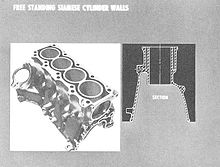 Vega aluminum engine block has 17 percent silicon content, free standing siamese cylinder walls
Vega aluminum engine block has 17 percent silicon content, free standing siamese cylinder walls
GM Research Labs had been working on a sleeveless aluminum block since the late 1950s. The incentive was cost. Engineering out the four-cylinder's block liners would save $8 per unit. Reynolds Metal Co. developed an eutectic alloy called A-390, composed of 77 percent aluminum, 17 percent silicon, 4 percent copper, 1 percent iron, and traces of phosphorus, zinc, manganese, and titanium — suitable for faster production diecasting, making the Vega block less expensive to manufacture than other aluminum engines. Sealed Power Corp. developed chrome-plated piston rings that were blunted to prevent scuffing. Basic work had been done under Eudell Jackobson of GM engineering. Then suddenly, Chevrolet got handed the job of putting this sleeveless aluminum block into production — a feat never before attempted.
The Vega blocks were cast in Massena, NY at the same factory that had produced the Corvair engine. The casting process provided a uniform distribution of fine primary silicon particles approximately 0.001 inches (25 µm) in size. The blocks were aged eight hours at 450 °F (232 °C) to achieve dimensional stability, then inpregnated with sodium silicate, [15]From Massena, the cast engine blocks were shipped to GM's engine plant in Tonawanda, NY where they underwent the etch and machining operations. The cylinder bores were rough and finish-honed conventionally to a 7 microinch (180 nm) finish then etched removing approximately 0.00015-inch (3.8 µm) of aluminum, leaving the pure silicon particles prominent to form the bore surface. A four-layer plating process was necessary for the piston skirts, putting a hard iron surface opposite the silicon of the block. From Tonawanda, the engines went to the Chevrolet assembly plant in Lordstown, Ohio.
The technical breakthroughs of the block lay in the die-casting method used to produce it, and in the silicon alloying which provided a compatible bore surface without liners. With a finished weight of 36 pounds (16 kg), the block weighs 51 lb (23 kg) less than the cast-iron block of the 153 cu in (2,507 cc) inline-four used in the Chevy II Nova.Review
Car and Driver, August 1973 said: "Cosworth Vega-16 Valve. More than an engine. A taut muscled GT coupe to devastate the smugness of BMW 2002tii's and 5-speed Alfa GTV's. A limited run of 4000 machines, each one built away from the tumult of the assembly line to precision tolerances, as a show of technical force by Chevrolet. All of them will be collector's items."
Car and Driver in its "History of 0-60" feature included the 1974 pre-production Cosworth Vega with the quickest time of 1974 at 7.7 seconds.
Car and Driver in a 1975 Cosworth Vega test said: "The outstanding feature of the Cosworth Vega is its excellent balance..Roll-stiffness distribution is ideal, with little understeer entering a turn, and just the right amount of drift from the tail as you put your foot down to exit ...Through the woods or down a mountain, the Cosworth is a feisty aggressor willing, if not altogether able to take on the world's best GT cars."
Motor Trend in a 1975 Cosworth Vega test said: "The Cosworth Vega goes like the proverbial bat out of Carlsburg Caverns" "At moderate speeds, the car is as close to neutral handling as any American car I have ever driven..."
Road & Track in a 1976 Cosworth Vega road test said: "The Cosworth Vega's handling is very good... All the drivers agreed that it is a far better handling car than those Vega derivatives such as the Monza that have been fitted out with V6 or V8 engines." "We can't resist saying that with the Cosworth Vega engine, the Vega now runs the way it should have run all the time-easy, smooth, good response, good handling: a nice balance between performance and economy. Sweet as it is however, the Cosworth Vega is still way down the excitement ladder from what it would be with another 30 or 40 bhp. Then it would really be something"
Road Test in a 1976 Supercoupe Shootout — Alfa vs. Mazda vs. Lancia vs. Saab vs. Cosworth Vega, said: "The results are in Figure 2. Reed 'em and weep, all you foreign-is-better nuts, because right there at the top, and by a long way at that, is the Cosworth Vega. It had the fastest 0-60 time, the fastest quarter-mile time, and tied with the Saab for the shortest braking distance".[16]"The Cosworth is American, and a collector's item, and it came close, damn close to winning the whole thing."[17]
Car and Driver chose the Cosworth Vega as one of the "10 Best Collectible Cars" in its fourth annual Ten Best issue, saying: "We're talking about historical significance here."
See also
References
- ^ Chevrolet press release - 1975 Chevrolet Cosworth Vega, March 1975
- ^ 1975 Cosworth Twin-Cam advertisement
- ^ Collectable Automobile-April 2000. Chevrolet's Vega
- ^ Road Test, December 1973
- ^ Car and Driver. October 1975
- ^ Cosworth Vega Owners Association-Cosworth Vega History
- ^ GM Heritage Center, Generations of GM History
- ^ 1975 Chevrolet Cosworth Vega Service and Overhaul Manual Supplement
- ^ GM Heritage Center, Generations of GM History
- ^ GM Heritage Center, Generations of GM History
- ^ Chevrolet 1975 Cosworth Vega Service and Overhaul supplement-General information
- ^ GM Heritage Center, Generations of GM History
- ^ Road & Track-March 1975. Chevrolet Cosworth Vega
- ^ Cosworth Vega Owners Association
- ^ Collectable Automobile-April 2000
- ^ The Great Supercoupe Shootout - Alfa Romeo Alfetta GT, Mazda Cosmo, Lancia Beta Coupe, Saab EMS, Cosworth Vega - Road Test magazine, October 1976
- ^ The Grand Finale. Hot laps of the track...the amazing thing about it all was that the Cosworth was next by a close tenth of a second." (Riverside Raceway Lap Times: Alfa Romeo Alfetta GT-1:58.61 Cosworth Vega-1:58.71), Road Test magazine, October 1976
Bibliography
- Gunnell, John, ed (1987). The Standard Catalog of American Cars 1946–1975. Krause Publications. ISBN 0-87341-096-3.
External Links
Categories:- Chevrolet vehicles
- Rear wheel drive vehicles
- Subcompact cars
- Coupes
- Hatchbacks
- Motor vehicles manufactured in the United States
- Vehicles introduced in 1975
Wikimedia Foundation. 2010.

